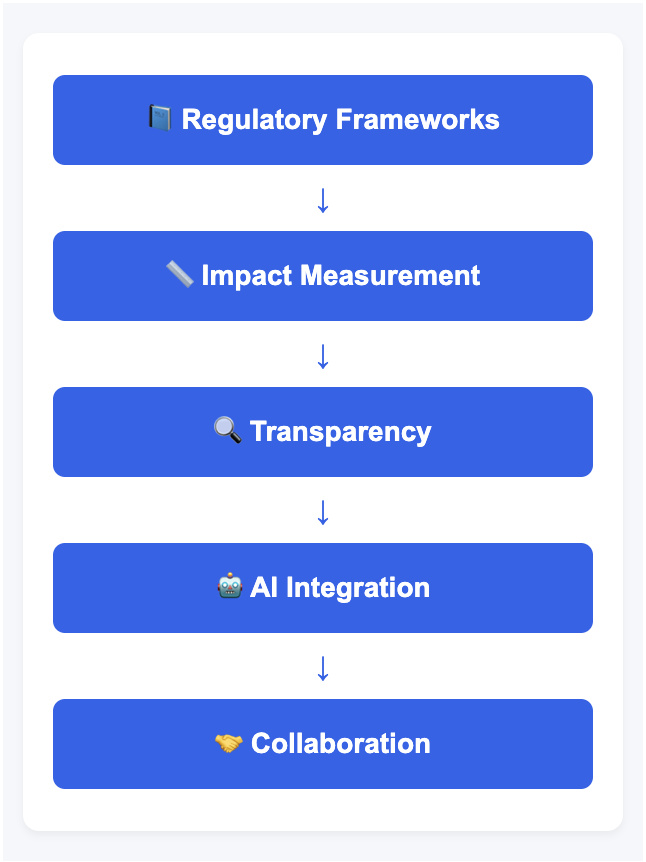By Mina Westby and Sambridi Shakya
Does putting your money where your morals are really change the world—or just make investors feel better?
Impact investing is booming. According to Global Impact Investing Network (GIIN) states that the market is $1.571 trillion in 2024, and is growing at a 21% compound annual growth rate (CAGR).
Impact investing isn’t just about feeling good—it’s about real change.
No longer a niche approach, impact investing is infiltrating mainstream portfolios, driven by a new generation of investors who want their dollars to make an impact on the world (hence the fitting name).The question is, are we witnessing a genuine financial revolution, or just another clever branding exercise designed to let investors sleep better at night? Can you increase your wealth while improving the world we live in? Or are you forced to choose between the two?
Let’s break it down.
The death of ESG: why “impact” became the new gold standard—and what it means for Australian and U.S. investors
For years, ESG investing was the darling of global markets, particularly in Australia and the U.S. Then it all came crashing down.
Greenwashing scandals, vague metrics, and political backlash—especially in the U.S.—turned ESG into a dirty word. Many companies wearing the ESG badge of honour were more focused on optics than actual outcomes, leading investors to seek more direct and measurable alternatives.
Enter impact investing. Unlike ESG, which focuses on risk mitigation and “doing less harm,” impact investing is about intentionally creating positive change.
The strategy is no longer just about avoiding oil companies—it’s directly funding climate solutions. It goes beyond corporate diversity reports—it’s investing in firms that are actively changing the game.
Critics of ESG argue that those funds often prioritise optics over genuine impact, prompting investors to seek more direct, measurable alternatives, whereas Impact investing is filling that gap, offering a clearer pathway to measurable social and environmental change. Anne Simpson, Global Head of Sustainability at Franklin Templeton, has emphasised the need for substantive approaches in sustainable investing. She has highlighted the importance of addressing conflicts of interest within the asset management industry and maintaining transparency with investors. While specific critiques of traditional ESG models are not directly attributed to her, her focus on governance and accountability aligns with the call for more impactful investment strategies
How women are quietly reshaping finance through impact investing
One of the biggest forces behind the rise of impact investing? Women.

In the U.S. alone, they are set to control $30 trillion, roughly 38% in assets, over the next decade. And here’s the kicker: women are twice as likely as men to invest with impact in mind.With female investors set to control trillions in assets over the next decade, their emphasis on long-term sustainability and ethical investing is accelerating the sector’s growth. More women-led investment funds are emerging, and gender-focused investment strategies are on the rise.
Why? Because women see money differently. Studies consistently show that female investors prioritise long-term sustainability over short-term gains. They favour investments in healthcare, education, and social equality—sectors traditionally undervalued in finance. According to a recent report from the Australian Financial Review, the trend is even more pronounced in Australia, where female-led investment firms are significantly contributing to the growth of impact investing. This aligns with our previous analysis on the role of gender in shifting financial priorities.
Jennifer Kenning, CEO and co-founder of Align Impact, has been a prominent advocate for integrating personal values and social impact into investment strategies. Align Impact, established in 2014, operates on the conviction that aligning the wealth management process with individual values can optimise financial systems and drive positive change.
Addressing the challenges: making impact investing work
While impact investing has faced skepticism, it’s also shown enormous potential. The key lies in refining its approach and improving accountability.
| Real Impact Investments | Potential Greenwashing cases |
| Mirova – A global asset management company dedicated to sustainable investment, managing €28.4 billion as of 2023. Certified B Corp. ]) | Volkswagen – Installed software in diesel vehicles to cheat emissions tests, leading to approximately €31.3 billion ($34.69 billion USD) in fines and settlements as of March 2020. |
| LeapFrog Investments – Specialises in high-growth financial services, healthcare, and climate solutions in emerging markets, reaching 492 million consumers. | McDonald’s – Faced criticism for replacing plastic straws with paper ones while maintaining a large environmental footprint. |
| Longreach Maris – Supports Indigenous fishers in Australia to access sustainable seafood markets, aligning social and environmental goals | Coca-Cola – Continues to be one of the largest global plastic polluters despite sustainability initiatives. |
| Australian Ethical Investment – An Australian fund with a strict ethical charter, investing in sectors that drive positive change. | Diamond Energy – A green energy provider facing allegations of misleading environmental impact claims. |
| Longreach Maris – An initiative supporting Indigenous fishers in Australia to access sustainable seafood markets. | BlackRock – Accused of greenwashing by marketing ‘sustainable’ funds while investing heavily in fossil fuels |
For all its promise, impact investing has its fair share of doubters—and honestly, they’ve got some decent points.
The key concerns:
- Returns vs. Real Impact: Some argue that impact investing is just a clever way to charge higher fees while delivering market-rate returns. The data, indeed, shows mixed results. While some impact funds outperform traditional benchmarks, others underperform.
- Impact Washing: Without clear, standardized metrics, some funds claim “impact” status without proving real-world results. How do we measure success? A tree planted? A tonne of carbon avoided? A life saved?
- Scale & Systemic Change: Can impact investing really shift the balance of power in global finance? Or is it a boutique strategy that makes us feel good while the biggest players—big oil, big tech, big banks—still control the markets.
- AI’s Role in Addressing Skepticism: One potential game-changer in impact investing is artificial intelligence. AI-driven analytics can help measure real impact with greater precision, reducing the risk of greenwashing. Automated tracking of sustainability metrics, real-time fraud detection, and predictive modeling could bring unprecedented transparency and accountability to the space. But there’s a flip side—AI could also be used to manipulate data and create misleading narratives around impact, reinforcing skepticism instead of resolving it.
Tariq Fancy, former Chief Investment Officer for Sustainable Investing at BlackRock, has expressed skepticism about the effectiveness of impact investing in addressing global challenges. In his essay series, “The Secret Diary of a ‘Sustainable Investor‘,” Fancy describes ESG (Environmental, Social, and Governance) investing as a “dangerous placebo that harms the public interest.” He argues that without systemic reforms and governmental intervention, such initiatives may divert attention from necessary changes. Fancy emphasizes that meaningful progress requires comprehensive regulation and systemic shifts, rather than relying solely on well-intentioned investors.
The future of impact investing: Where do we go from here?

To ensure impact investing delivers real value, investors, regulators, and businesses must take the following steps:
- Stronger measurement standards: Investors must demand transparency and universally accepted metrics to track actual impact and prevent “impact washing.”
- Accountability from big players: Large institutions like BlackRock and Goldman Sachs should be held to higher standards to ensure their impact investments are not just PR moves.
- Encouraging long-term investments: A shift away from short-term financial gains towards long-term, sustainable change is crucial for making real progress.
- Leveraging AI for transparency: AI and big data can play a key role in verifying sustainability claims and preventing greenwashing, rather than being used as a marketing tool.
By implementing these improvements, impact investing can go beyond being a feel-good trend and become a fundamental pillar of modern finance, one that genuinely benefits both investors and society.
- Regulatory changes: Governments in Australia and the U.S. are ramping up regulations around sustainability reporting and greenwashing claims. Investors should monitor new policies that could impact impact-driven portfolios.
- AI integration: AI is playing a bigger role in tracking sustainability outcomes, fraud detection, and transparency. The challenge is ensuring AI is used for accountability, not for manipulating data.
- Key sectors: Renewable energy, fintech for financial inclusion, and sustainable agriculture are expected to attract the most capital in the coming years.
What’s next?
- Stronger measurement standards: Investors are demanding better data, pushing for universally accepted impact metrics to prevent “impact washing.”
- Bigger players, bigger stakes: BlackRock, Vanguard, and Goldman Sachs are all deepening their impact offerings, signalling mainstream adoption.
- More women, more influence: As female investors control more wealth, expect impact investing to become the default strategy rather than an alternative.
Impact investing isn’t going away. In fact, it’s likely to become the defining investment strategy of the 21st century, particularly in Australia and the U.S.
Final thoughts: how impact investing can drive real change
Impact investing is not just a trend—it has the potential to reshape finance by proving that profit and purpose can coexist. While skeptics argue that it’s just a marketing tool, there are undeniable examples of real change being driven by these investments.
At its best, impact investing funds innovation, supports underserved communities, and creates tangible, positive change. A prime example is Longreach Maris, an Australian initiative helping Indigenous fishers gain access to sustainable seafood markets, empowering local communities while promoting environmental responsibility At its worst, it’s a marketing ploy that allows companies to claim sustainability credentials without meaningful action.
The key challenge is ensuring that impact investing delivers real-world results, whether through measurable financial returns, sustainability milestones, or meaningful policy changes rather than just good PR. Stronger regulations, better measurement tools, and transparency will determine whether this movement reshapes finance or fades into another passing trend.
The real question isn’t whether impact investing will keep growing, it’s whether it will lead to real systemic change or just become another trendy financial product. Is it capable of driving reform, or will it just become a way to make capitalism look better?
Here’s the uncomfortable truth: Capitalism isn’t built to save the world. It’s built to make money.
If impact investing is going to succeed, it has to prove that profit and purpose can coexist without compromise.
The biggest players—BlackRock, Vanguard, and Goldman Sachs—are getting deeper into impact investing. Their growing involvement has both positives and concern and their massive capital can accelerate funding for sustainable projects, making impact investing more mainstream.
AI is about to shake up impact investing in a big way—especially in markets like Australia and the U.S. On one side, it has the potential to inject real accountability by tracking sustainability metrics in real time, detecting greenwashing scams, and using predictive analytics to ensure capital goes where it truly matters. But let’s not kid ourselves—big money will always find ways to manipulate the narrative.
On one hand, it offers powerful tools for impact measurement, fraud detection, and predictive analytics that could make investments more effective and accountable.
On the other hand, it could also be weaponised for greenwashing: generating polished reports that make companies look sustainable without substantive change.
A couple of questions we need to ask ourselves:
- Can impact investing evolve into a real driver of change?
- Can impact investing and portfolio gains coexist?
- Is this the dawn of a new financial era, or just another way to dress up capitalism in a friendlier outfit?
The jury’s still out.
Disclaimer: The information provided is factual and sourced from reputable organisations. It is for informational purposes only and does not constitute financial advice. © 2025 JHC Operating Co Pty Ltd (formerly Neural One Australia Pty Ltd) is an authorised representative of Jaaims Technologies Pty Ltd (Australian Financial Services Licence 519985).
